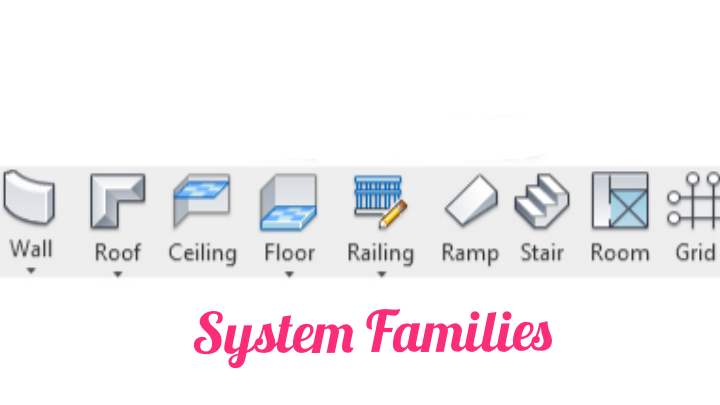Table of Contents
Introduction:
Revit families are groups of elements that share common characteristics, such as similar properties and visual representation. Everything we deal with on the Revit platform is intricately linked to a family, which marks its central role in our interactions with the software.
Elements such as walls, columns, mechanical equipment, and annotation labels all belong to specific Revit families, which are appropriately placed in a predefined hierarchy. At the extreme of this hierarchy are Revit categories—primary units of classification that remain immutable, impervious to creation, modification, or deletion. These categories serve as the basic structure that provides organization and cohesion to the software ecosystem.
Types Of Revit Families
There are 3 main types of families in Revit software. They are system family, component family and in-place family. We will learn about these Revit families.
1. System Family
Systems are like the building blocks used on family construction sites, such as walls, ceilings, floors, pipes and ducts. They are preset parts in the Revit platform and cannot be added or removed from the interface. These come with predefined settings, thereby saving time.

We can copy and adjust ‘types’, which are sets of attributes such as material and size, to meet the needs of the project. For example, a basic wall has different types such as a generic 4″ or exterior brick on the CMU. You can transfer these between projects using “Transfer Project Standards”.
2. Component Family
Loadable families are the regular components like doors, windows, furniture and more that you would use in a building. You can create and modify them depending on the needs of your project.

Unlike System Families, you can save these as separate files and add them to the project whenever needed. This speeds up modeling and improves accuracy.
3. In-Place Family
In-place families are custom elements created for specific projects. They are similar to loadable families in how you create and edit them. They are unique to the project and do not have multiple ‘types’. You cannot save them separately. They’re great for complex designs, and you can copy them between projects, although it’s best to use them sparingly to avoid large file sizes and software slowdown.
Other Useful Revit Families
(a) Profile Families:
Profile Families are like special shapes that we can use to make different parts of buildings, like walls, beams, and columns look unique. Imagine you have a piece of clay, and you can shape it into different forms to decorate your playhouse. That’s what Profile Families do for buildings!
(b) Annotation Families:
Annotation Families are like little helpers for drawings. They create symbols, words, and labels that give extra information in drawings. Think of it as adding stickers and notes to your drawings to show important things, just like how you might add smiley faces and comments to your artwork!
(C) Loadable Families:
Loadable Families are like building blocks that we can make outside of the building project. These blocks can be put into many different projects. They include things like important parts of buildings (component families) and labels (annotation families). It’s like making cool LEGO pieces that you can use in lots of different playsets!
(d) Hosted Families:
Hosted Families are like friendly visitors that need a place to stay in a building. They are made to fit with other things in a building, like a light attached to the ceiling or a railing on a staircase. Imagine you have a doll that sits on a chair in your dollhouse – that’s how hosted families fit into buildings!
(e) Nested Families:
They are families that we use inside other families to make things complicated but super cool. For example, if you have a toy set with different furniture, and one piece of furniture has its own tiny toy inside it – that’s just like how nested families work in buildings!
Advantages Of Revit Families
Revit enhances accuracy through its Dimension tools, allowing precise assignment of dimensions to diverse components within a Revit family. Upon placing a family item, Revit automatically allocates dimensions to the constituent elements.
The Family Editor offers remarkable flexibility by creating both 2D and 3D families, which can be either parametric or non-parametric. Parametric families permit streamlined adjustments in materials and sizes, while storing multiple variations as types. Non-parametric families possess fixed properties in terms of shape and size, remaining unalterable. Both parametric and non-parametric families serve distinct purposes in 3D architectural modeling.
Streamlined modification is a key feature, as families in Revit can be effortlessly altered using the appropriate tools. This empowers designers and engineers to execute precision-driven designs and constructions.
Time and effort are conserved significantly through Revit families, as professionals spend less time on modifications. The family components can be repurposed across different projects, thus effectively economizing valuable time and effort.
